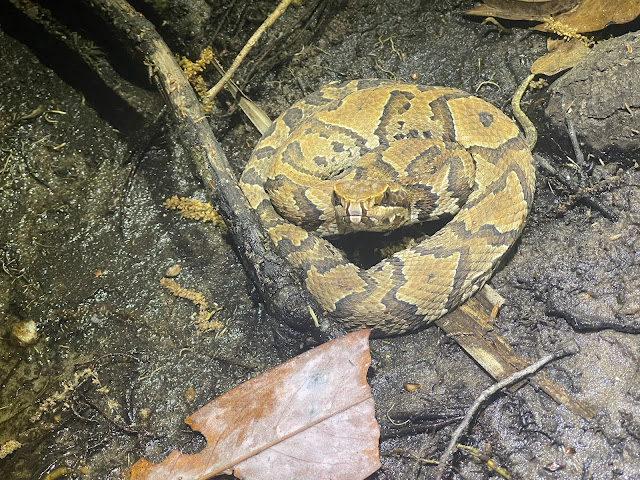March 9th began with an early morning start in Peter’s front yard, where I found a southern ringneck snake (Diadophis punctatus) under a log. But we had bigger fish to fry that day - soon we were headed to Apalachicola National Forest, an expansive natural area encompassing multiple types of habitat. Our first stop was a beautiful woodland full of seeps, sand hills, and salamanders. Once we were out of the car and in the woods, the mosquitoes made it abundantly clear that we were not at the top of the food chain here. We persisted, pushing through and carefully turning cover as we went. We found a southern toad (Anaxyrus terrestris) and a narrowmouth toad (Gastrophryne carolinensis) before reaching an area that looked very salamandery. We ended up finding a number of three-lined salamanders (Eurycea guttolineata), southern two-lined salamanders (Eurycea cirrigera), southeastern slimy salamanders (Plethodon grobmani I think), and Apalachicola dusky salamanders (Desmognathus apalachicolae). I also spotted a large adult Gulf Coast box turtle (Terrepene carolina) ambling along a seep, and while making my way up a sandy hillside, found a gopher tortoise (Gopherus polyphemus) burrow, excavated right into the steep dune. Since we skipped breakfast that morning, we were building an appetite, one that can only be cured with Waffle House. So off to WH we went, to further broaden my junk food road diet horizon.
We wanted to make our rendezvous with Peter and friend Hari Parasu, so we hopped back in the car and headed toward the paved roads which lead back to Tallahassee. As the car crunched over the gravel road toward the main highway, Nathan shouted, “Pygmy!” again. I slammed on my breaks and all three of us jumped out of the car. Indeed, a pygmy rattlesnake was in the process of crossing the road, so we took some photos and moved the snake off of the road to safety. Success!
Back in Tallahassee, Tom, Nathan, Peter, Hari, and I transferred to Peter’s vehicle, which took us to a VERY remote stretch of coastal Florida. We were hoping to see blue-striped ribbon snakes (Thamnophis sauritus) among other species. Temperatures were dropping rapidly, though, threatening our chances. When we didn’t spot a single snake, we decided to turn our attention to the one-toed amphiuma (Amphiuma pholeter). We netted some roadside ditches and swampy areas to no avail. It was very dark, and the calling barred owls added to the spooky ambience of our outing. Before we left, we did end up finding a single banded water snake as well as a young cottonmouth. The odds seemed to favor amphibians due to the temperatures, so our next stop would be a local spring-fed lake Peter and Hari like.
We arrived at the lake access point, where a boat launch and small beach had been constructed. Tom shined a newt in the water, walking along the boat ramp surface. A southern toad was seen emerging from its sandy spot on the beach, and several leopard frogs were calling. A pine woods treefrog (Hyla femoralis) was spotted on a tree, and Nathan managed to catch a good-sized bowfin. Hari and I separated from the others and walked the boardwalk to a large cypress tree that doubles as a launching pad for rope swingers. By chance, my flashlight beam caught a brightly-colored, serpentine form along the tree’s knees. It took a moment but eventually I identified the colorful thing as a scarlet kingsnake (Lampropeltis elapsoides). This is where things get dicey. In order to catch the snake, I had to take a “leap of faith”, reaching out with one foot to land it on the top of one of the cypress knees in one shot. Then, I could stabilize myself and reach the snake with one hand while supporting myself against the tree with the other. I handed Hari my flashlight and quickly made the move. I managed to catch the snake and get back to the boardwalk without slipping in my muck boots and landing in the drink. Our excitement was over the top. This animal was absolutely beautiful, a real jewel. We all met up and everyone was able to get some photos before the snake was released exactly where it was found minutes later. It was a fine way to end the day.
A stunner of a scarlet king!
Check back for the final installment!














.jpg)







No comments:
Post a Comment